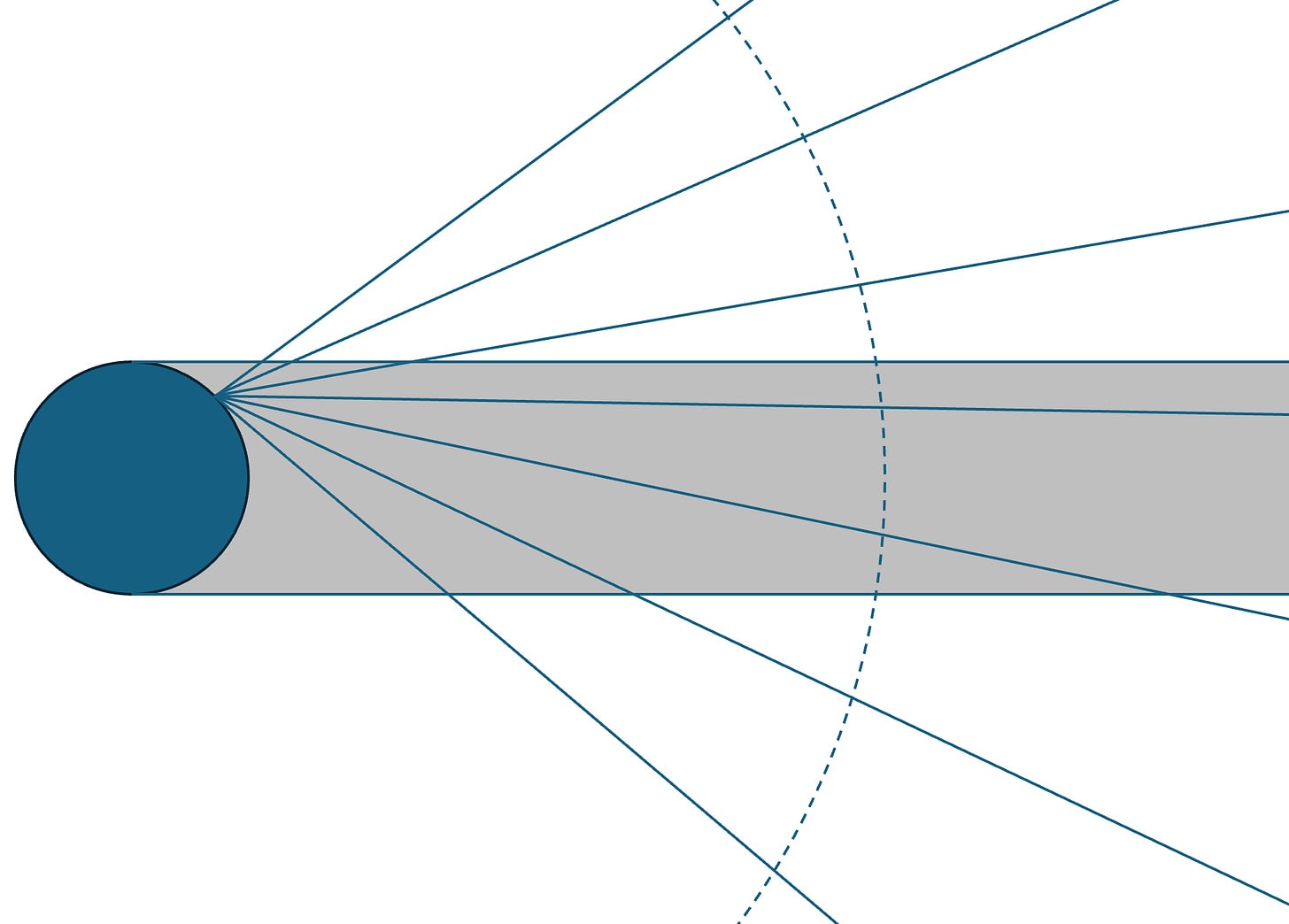This is a crosspost for Pre-Sputnik Earth-Orbit Glints by Robin Hanson, which was originally published on Overcoming Bias on 17 August 2025. Relatedly, I enjoyed this podcast of Event Horizon with Beatriz Villarroel, lead scientist of the project which analysed the glints.
IMHO, the strongest evidence so far that (some) UFOs are aliens just dropped. (OK, two weeks ago.) This evidence is of many brief bright glints of sunlight reflecting off of big surfaces in high orbit around Earth, before humans had put anything up there, and correlated in time with both UFO reports and nuclear tests.
Glints are brief flashes of the Sun (or other bright sources) off of flat reflecting surfaces. On Earth, and in the rest of the solar system, natural glints come mainly from flat surfaces of water or ice. (Rarely, wind polished rocks glint.) On Earth today, correcting for water, glints are strong indicators of human spaces, due to our many flat reflecting surfaces.

Modern automated telescope sky surveys see ~1800 glints per hour per sky near the equator (as of ~2020), and three good LLMs told me we are pretty sure, via multiple lines of evidence, that most all these glints are due to human-made satellites and their debris. Typical momentary brightness of these glints is magnitude 9 to 11, and making glints this bright requires (I think) an ideal ~1-2cm diameter circle at geosynchronous orbit [GEO] (42K km radius). Real glinting objects are smaller than this if closer to Earth, but larger if not perfectly flat, aligned, or reflective.
It is thus quite surprising to learn that there seem to have been ∼340 big glints per hour per sky (~1/5 of current rate) before we humans launched our first satellite, Sputnik, on October 4, 1957!
Says who, you ask? The First Palomar Sky Survey, using the 48-inch Schmidt telescope at Mount Palomar 1949-1958, was the first comprehensive photo survey of the entire northern sky. It took almost 2,000 square photos, each covering about 6° on a side. Typically, each region was photographed twice in a row, once using a plate sensitive to red light for ~50 min, and then one sensitive to blue for ~10 min.
These plates were later digitized, and recently the VASCO project [good name] has looked for “transients”, i.e., objects seen in the red but not blue plates. For example, three close transients appear in the middle of the left plate but don’t appear in the right. And, as usual, they are never seen by any later telescopes.

Due to telescope imprecision and atmospheric fluctuations during photo exposure, each space source shows up on the plates as a circular blob about two arc-seconds wide. Blobs of the transients seem narrower, sharper, and more round than others, suggesting that their sources were visible for only part of the plate exposure duration.
We have good reasons to think most of these transients are brief glints of sunlight off of flat reflective objects in the rough ballpark of Earth GEO, as opposed to being defects in the photo plates, self-illuminating sources like stars, or sources much closer or further.
What reasons? If one assumes that sources are either at 42K km (GEO) or 80K km radius orbits, then one can calculate for each source whether the Earth blocks its view of the Sun. If most of these transients are glints reflecting sunlight, and if their sources are about this far away, then we should see far more glints in places that are calculated to be in sunlight, relative to in shadow.
And in fact, in a dataset of 106,339 transients from these plates, using the rate at which we see transients in sunlight regions, at 42K km and with no shadow effect we’d expect to see 1223 transients in shadow regions, but we actually see only 349. And at 80K km, we’d expect to see 339 in the shadows, but see only 79. These differences are significant at 21.9 and 12.7 sigma levels! Thus at least ~2/3 of these ~100K 1950s transients are in fact brief glints off of flat shiny objects in roughly GEO! (See explainer in Added section below.)
How brief? As objects in GEO move about 15 arc-seconds per second, these had to be <~0.04 sec duration glints to not noticeably stretch their 2 arc-second photo blobs (at least in the higher resolution scans). Also, ~80% of the glints have magnitude 17-19, though those three close transients shown above were magnitude 15-16.
At GEO it would take an ideal ~22-35 cm diameter circle (perfectly flat, aligned, and reflective) to create a magnitude 15-16 image in these photos from a 0.04 sec glint. (Or so says ChatGPT5.) For magnitude 17-19, that changes to an ideal 6-14 cm circle. Objects less than perfectly flat, aligned, or reflective, or with shorter duration glints, would have to be larger. Objects close to Earth could have smaller areas due to that, but would also have to be larger due to closer objects orbiting faster.
Thus while today Earth sees ~1800 glints per hour off of the roughly ~1-2cm equivalent diameter ideal circle sized human satellites and debris, in the decade before Sputnik, the space around Earth generated ~340 glints per hour mostly from brief (<0.04s) glints of sunlight off of at least roughly 6-14cm equivalent ideal circles. While this makes the older glint distribution seem different from today’s, note that the older telescope couldn’t see the fainter glints that today’s telescopes can see. So the two distributions might actually be the same.
We’ve never seen a regular sequence of glints, with at least three in a row equally spaced in a line across the sky. But there are many clusters of glints, more than you’d predict at random, like the three in the picture above. So the structures and distributions of these objects must be complex.
The distribution of apparent magnitudes of these glints seems to follow the same power law as the distribution of apparent stellar magnitudes. That may seem puzzling until you realized that in both cases the power may be dominated by how counts and brightness vary predictably with distance.
These glints also seem to have a significant date correlations with nuclear tests and UFO reports. Glints were 45% more likely (p = 0.008) on dates within one day of nuclear tests, and there was a significant (p<.001) correlation between the number of UFOs reported and number of glints on each date. In fact the cluster of three close glints above appeared on July 19, 1952, during one of the most famous UFO events of the era at Washington DC. (They were 2km apart if at GEO.)
If water and ice are the main sources of glints in the solar system, could big flat ice crystals be the source of these 1950s glints? I’m told that by volume most ice in near Earth space is in ~1-2mm diameter flakes, and by count most is in sub-micron specks, both of which seem way too small to cause these big glints. Also, wouldn’t they melt, and how could a random field of big ice crystals make the observed glint correlations? Also there’s that big literature saying almost all glints today are man-made. Even so, someone should check if we’ve somehow missed many ~10 cm flat ice crystals.
As that seems a long shot, it seems we must take seriously the claim that these were glints off of big flat reflective parts of advanced devices from an alien civilization. That kinda hurts to type, knowing that many of you will respect me less for saying so. But I gotta go where the evidence leads.
Now obviously the authors behind these studies might have made big mistakes, and the world should want to see confirmations using other analysis and datasets. And we should worry a bit that they, or those who supplied them data, might be fronting for an expensive psych-op that is faking evidence to push some narrative.
My guess, however, is that this isn’t a psych-op, and they didn’t make big mistakes in the above analysis. Making this pretty big news.
Note that the object shapes needed to product such glints seem pretty different from many usual UFO shapes, such as saucers or tic-tacs. Typical human satellites are fine:

Added: The initial version of this post used a 0.01s max glint time estimate, but after some criticism I relaxed that to 0.04s.
Added 18Aug: This diagram helps show the intuition re the shadow calculation:

Here Earth is the blue circle, GEO is the dotted curve, and seven lines of sight come out from a telescope looking up at its night sky. Two of those lines are in shadow at the orbit position, but tracing those lines inward and outward we can see that their shadow status changes. The further an object is from a reference orbit, the lower will be the correlation between whether it is actually in shadow and the shadow calculation using that reference orbit. So the stronger is the correlation between this shadow calculation and actually showing glint reflections, the closer those objects must be to that reference orbit distance.
Added 22Oct: The papers are now published.
